MOTORNET: Honda's Accord Euro Is That Good!
Honda Accord Euro
Motoring Review by Karl Ferguson
Images By Neil MacKenzie - http://www.onlinefotos.com/
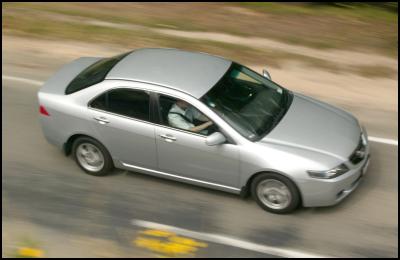
As a motoring writer, I have a problem with Honda's new Accord Euro. I knew I had a problem a mere five minutes after getting behind the wheel. You see, it’s so impressive that my overwhelming tendency - rather than to write a considered, well researched piece - was to simply advise anyone even remotely in the market for a mid-size sedan to buy the Euro immediately. No questions asked.
Unfortunately, at its best, motoring writing is objective, and at its worst, more than a little subjective. It has occurred to me that even the least discerning of new car buyers will need more than a bald-faced imperative from me to be convinced that the purchase of Honda's latest offering is a good thing for them.
Which is a bit of a nuisance in many respects because the Euro really is that good. Quite simply, Honda has created a package that should have universal appeal. For a start, at $35,000, it undercuts many of its competitors on price including similarly specced Subaru Legacy, Holden Vectra and Mazda 6 models. Having said that, Honda have a 'no discount's' policy so it is possible that some good old fashioned haggling will see other car manufacturers, meet, if not beat Honda's bottom-line.
But given the bargain basement price tag, you might expect Honda to have produced a no-frills sedan. Not so. On first site, the Euro could be mistaken for a high end European express rather than a mass-market mid-sizer. Its wedge shape is distinctive, but classy - though it may not be to everyone's taste, especially during reversing! The high boot line and high sills taper to a nicely sculpted front end that is topped off - at least by Honda standards - a large scooped grill. It works well, while the chrome door handles, chrome surround on the sill and front end add a nice touch, as do the twin pipes at the back. Alloys are stylish, but at 16" inches are just a mite small for the wheel arches, slightly spoiling of the over all look. Standard driving lights and indicator lamps on the wing mirrors complete the modern and stylish design package.
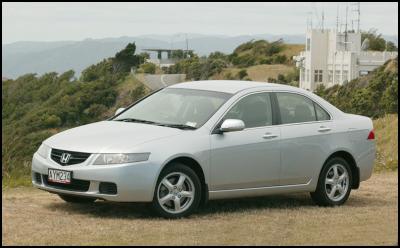
It's a theme that is continued on the inside as well. Ergonomically, the interior is a cut above. The steering wheel - which includes controls for the stereo and cruise control - is pleasantly meaty to the touch, while the large instruments are clear and easy to read. Seats are comfortable but well bolstered, while the velour upholstery feels of good quality. Finding a comfortable driving position is easy, and greatly helped by the tilt and telescope adjusting wheel, though surprisingly, the headrest is non adjustable.
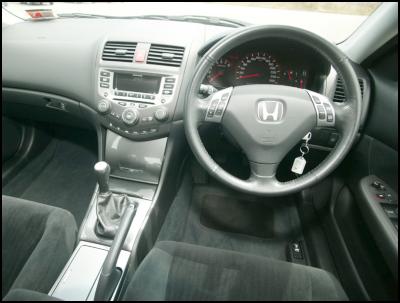
The major controls are grouped together on one central receptacle - including dual climate air con and stereo, which includes a six stack, in-dash CD player. The layout is simple but extremely effective. There's plenty of room left around the cabin for storage bins, though the faux aluminium cover over the central storage bin mars an otherwise faultless interior. Can't fault the fit and finish however, or the head and legroom which is generous in the front and above average in the rear. Four airbags and vehicle stability assist are also standard.
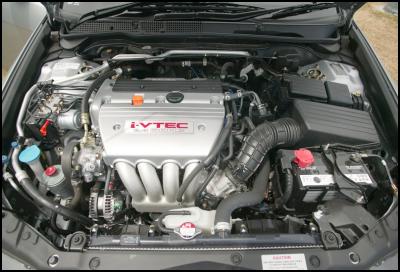
Still sceptical? Taking a look under the bonnet may sway otherwise unconvinced purchasers. Honda's familiar but excellent 2.4 litre four cylinder engine resides in the engine bay and it produces some pretty impressive numbers. Try 140kw and 223nm of torque at 4,500 rpm. It wasn't so long ago that a standard Japanese three litre V6 aspired to those kind of figures! Combined with Honda's VTEC system (Variable Valve Timing and Electronic Lift Control) that adjusts the lift and opening of the valves to improve performance, the Euro fairly rockets along. How does 0-100km/ph in 7.3 seconds sound? A recent NZ Autocar comparison recorded 8.23 seconds and 9.41 seconds respectively for similarly equipped Mazda 6 and Holden Vectra models.
And if it sounds quick in theory, it feels even quicker in practice. There's plenty of low down grunt and still plenty of go at the high end of the power band. Just grab a gear and go. The only downside is that putting so much power through the front wheels can result in torque steer and while it's not a major detractor, it's certainly detectable under hard acceleration on New Zealand's typical B grade roads.
The good news is that the transmission makes the most of all the power that's on offer. The test car came fitted with the standard six-speed manual, though a five-speed auto with pseudo manual function is available and will most likely account for the majority of sales. But if you like to change the gears yourself, you won't be disappointed by the manual option. It's slick and fast, with short throws, snicking nicely from gear to gear. Skipping a ratio from six to four or five to three can be habit forming, but working your way up and down the ratios is still a lot of fun. Interestingly, the gearbox felt noticeably looser after a few hundred kilometres. Possibly my imagination or more likely, the gearbox simply freeing up with time.

On the road, the Euro also manages to impress. Ride is definitely on the firm side which may put off those of us who would rather be cosseted and comforted over every bump, but the firmer set-up sure pays dividends in the handling stakes. The Euro feels supremely stable, cornering with confidence. At the limit, predictable understeer is the order of the day with front wheels providing the driver plenty of feedback through the informative steering. Most of all, it's loads of fun - much more fun arguably than is considered decent in this particular vehicle category. Some reports suggest the Mazda 6 is slightly ahead in the handling field, but even if that's the case, the Euro is still damn impressive.
To top it all off, the Euro is exceptionally quiet. Road noise is impressively low and intrusions into the cabin surprisingly few. It’s also impressively miserly in the fuel consumption stakes boasting a combined cycle figure of 9.1 litres of fuel per 100 kilometres – no doubt helped by a seriously low drag coefficient of 0.26.
Convinced? You should be – especially after such an exhaustive and thoroughly reasoned review! It’s true that the bar has been set pretty high in recent years as new models displace yesterday’s heroes, but Honda have raised it yet again. By all means, drive the Euro for yourselves if you need any more convincing. Or instead, just write out a cheque. Might pay to post date it though - as of late, Euros have been in short supply. No telling when you might get your hands on one....
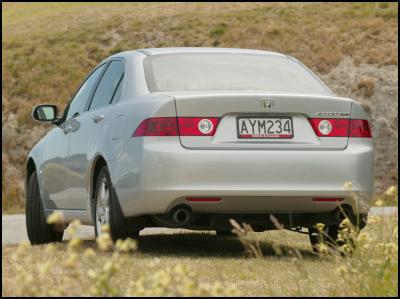
*** ENDS ***


 Keith Rankin: Who, Neither Politician Nor Monarch, Executed 100,000 Civilians In A Single Night?
Keith Rankin: Who, Neither Politician Nor Monarch, Executed 100,000 Civilians In A Single Night? Eugene Doyle: Writing In The Time Of Genocide
Eugene Doyle: Writing In The Time Of Genocide Gordon Campbell: On Wealth Taxes And Capital Flight
Gordon Campbell: On Wealth Taxes And Capital Flight Ian Powell: Why New Zealand Should Recognise Palestine
Ian Powell: Why New Zealand Should Recognise Palestine Binoy Kampmark: Squabbling Siblings - India, Pakistan And Operation Sindoor
Binoy Kampmark: Squabbling Siblings - India, Pakistan And Operation Sindoor Gordon Campbell: On Budget 2025
Gordon Campbell: On Budget 2025